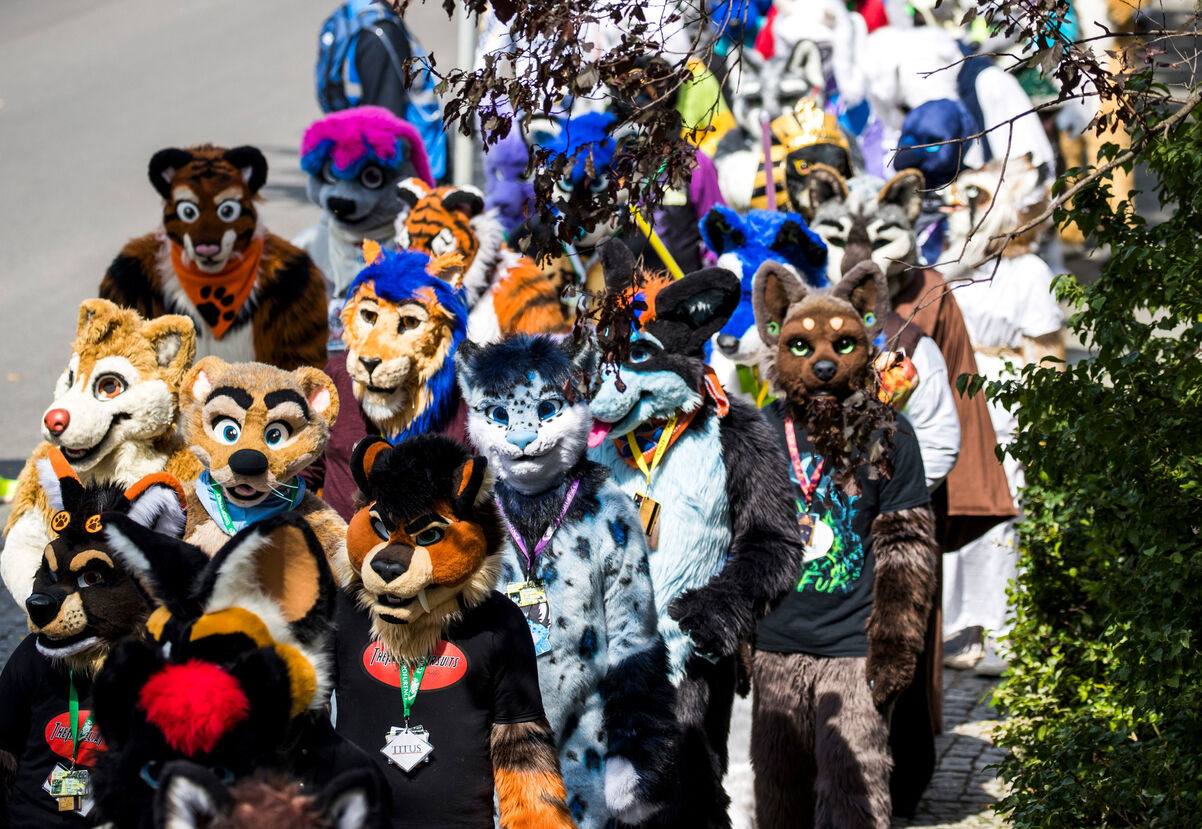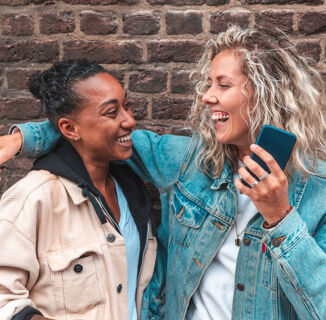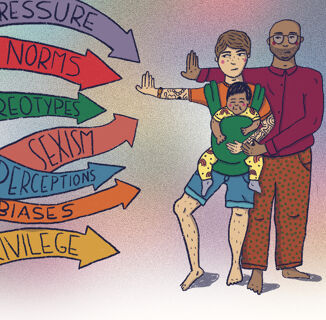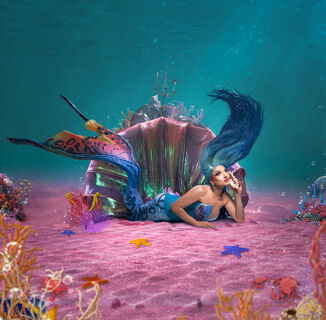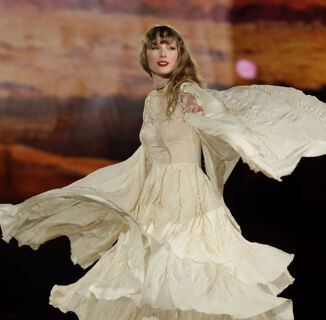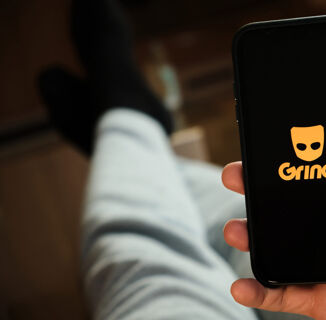Even in an age when sharing mundane details online is standard, it’s easier than ever to control the way others see usuntil, as people often say on social media, someone’s been “exposed.” Welcome to Exposed, a monthly column where author and activist Chris Stedman invites you to get a little more vulnerable.
I turned the corner, pulling onto the road for the hotel by the airport, and suddenly, I saw them.
First, there was onea fox with an enormous tail of unnaturally red furand then another, a grinning blue wolf with a jaunty tongue slipping from his jowl. Soon, there were swarms of them, packs of humans wearing tails, ears, and some even bright, full-body animal suits, all migrating toward the Chicago O’Hare Hyatt.
To the uninitiated, like me, there was something almost unnerving about seeing these giant fuzzy creatures out in the open, walking down the sidewalk unashamed instead of holed up in one of the hotel’s conference rooms. But there was also something thrilling about it.
The costumes looked hot and clammy, but it was me who was sweating. I was about to meet real-life furries in the flesh.
A few weeks earlier, I had interacted with my first furry, Steve, on Twitter. After he drew an illustration of my friend Tarik as an animal, he said that he could draw me, too. We DMed for a bit, and I asked if he’d give my fursona (or “furry persona”) a family resemblance to my dog, Tuna. I sent him a link to my Instagram so he could see pictures of Tuna and me, and he got to work.
A few hours later, he sent over his illustration. Looking at this human-dog with giant ears, teal-streaked hair, and a playfully-protruding tongue, I was taken aback. It was a cartoon of an animal, but somehow, it felt like me. In his smirk, the glint in his eyes, and the human hands making a posed selfie peace sign, I saw elements of myself. He even had my nose rings and a “QUEER” tattoo on the same wrist I do.

But the resemblance was more than surface-level, and taking it in felt revelatory. The drawing hinted at an unseriousness, even a friskiness, that I sometimes have a hard time seeing in myself. Grinning, I leaned forward on my bed to show Tuna, and she looked back and forth between my phone and me. I may have been imagining it, but it looked like she approved.
Steve and I kept chatting after that, and while I didn’t want to be a cultural tourist, I had never knowingly interacted with a furry before. After a few days of gracefully and patiently answering my dumb inquiries, he mentioned that he and his boyfriend were heading to Midwest FurFest, an annual gathering of hundreds of furries. I was already going to be in Chicago that weekend, so he suggested that he could get me into the closing party of the convention, which he was scheduled to DJ.
I immediately wanted to say yesit would be an incredibly unique opportunity to observe and interact with a community of people I knew almost nothing about. But I was suddenly becoming anxious. There would be cameras, he said. What if someone saw a picture or video of me there?

Steve understood my anxiety. When he was 14, his dad found some furry art he had drawn and sat him down for a talk.
“I’m not saying you’re a freak,” his dad said, “but this isn’t stuff that normal people look at.” Shamed, Steve repressed his interest for years.
Eventually, he began to dip his toe back in the water online, following furry artists and posting some of his own work. At 18, he went to his first furry convention. Surrounded by people who understood him, Steve knew immediately that this was his community. He hasn’t looked back since, and today he is a leading voice among furriescreating furry art, DJing furry events, spurring conversations about social justice online, and pushing back against alt-right and Nazi furries.
Unfortunately, those alt-right furries have pushed back. Shortly after the furry convention, they abused Twitter’s reporting system to get Steve suspended. He has also been doxxed multiple times, meaning personal details like his real name and even his home address have been exposed online by hostile antagonists. But these experiences have just emboldened him further. After working through his shame and fear to embrace who he is, Steve no longer worries what other people know about him.
Because of my exchanges with Steve, I’ve now interacted with large swaths ofFurry Twitter. Surveying the illustrated avatars and animal names popular among furries online, it’s easy to think about furry identity as a means of hiding. But talking with Steve, it’s clear that, for most furries, that couldn’t be further from the truth. The paradoxical reality is that, for many, donning an animal identity is actually about revealing, not concealing, themselves.
As I learned at the furry convention, creating a fursona and wearing a furry suit (or “fursuit”) can actually encourage vulnerability. For many furries like Steve, a fursona is an extension of who they are as a person, something I got a glimpse of when I saw elements of my own personality captured in an illustration of me as a dog created by a stranger, based entirely on pictures I’ve posted online. Putting on a fursuit or adopting an animal identity can help some furries get past social anxiety, bringing out aspects of their personality that they may have a harder time expressing on their own. For others, creating a fursona or wearing a fursuit can even be aspirationala way of creating a version of themselves that they can live into, something that conveys who they are working toward becoming.
While not all furries have fursuits, due to the cost and limited availability of fursuit makers, most furries put a great deal of time and thought into their animal identities.
Some furries even have more than one fursona: Steve’s boyfriend has a giant hyena suit, which is often for embodying his more dominant side, and a red panda suit, which he has associated with being more submissive. When used like this, fursonas are less a vehicle for hiding, and more an avenue for self-expression that recognizes the complex intersection of the many traits we all carry within ourselves.
Furries are a hugely misunderstood community; they exist at the margins of our culture, and are generally only brought up to be dunked on. If they’re mentioned at all, they’re usually either the butt of a joke or something regarded with suspicion and fear. But “normies” (furry terminology for non-furries) can learn a lot from the ways in which furries push back against that shame and embrace the complexity of being, well, human.

Mainstream portrayals of furries frequently center the sexual aspect of the community, but these one-dimensional depictions unfairly ignore the wealth of creative expression in the community. Yet a knee-jerk denial isn’t the answer, either. A complete and honest discussion of the furry community should of course include sexuality, while shifting the focus from reinforcing stigma through either overemphasis or denial to embracing sex positivitybut it should also acknowledge that there is more to the community than that. Especially because the community can provide a path to all kinds of self-discovery. Steve was starting to figure out that he was gay when he first became involved with furries, and it was there that he learned to become comfortable with his sexuality.
Steve’s story is not uncommon, and it’s not incidental that he and others might find queer acceptance among furries. In fact, while just over 80% of non-furries report being exclusively heterosexual, fewer than 25% of furries do. Similarly, 2.0-2.5% of furries identify as transgender and 10% identify as genderqueerboth significantly higher percentages than among the general public.
Now, years after he first got involved in the community, Steve’s days of worrying what other people think of him are long behind him. If shame is rooted in a fear of being unworthy of belonging, Steve has no need for it, because he’s found an inclusive community that not only welcomes who he is, but allows him to celebrate it.
And me? I may not be a furry, but these days I’m spending a lot less time worrying what others think about me, too. For years I struggled with the fear of being made to feel vulnerable and judged. This anxiety, exacerbated by years spent in the queer closet, dictated too many of my choices. But I am learning to let some of that go, and meeting Steve has helped me live into the messiness of who I am. Which is why I not only went to the convention but, once there, accepted an invitation to join him on stage.
Dancing in front of hundreds of people during Steve’s DJ set as cameras filmed the scene, I looked out over a pulsing sea of conference attendeessome in oversized suits of neon fur, some wearing just ears or tails, and others largely unadorned beyond badges stating their characters. Wondering how hot those wearing fursuits were quickly gave way to pure, unadulterated joy. They jumped and laughed, lifting their hands, paws, and hooves into the sky, giddy to be in a space where everyone could express themselves without scrutiny. And when I posted pictures and videos from the convention, I didn’t worry about what people thought, either.
Shame can kill, but it doesn’t always. More often the fear of being our fullest self just eats away at us like acid, gradually hollowing us out until the version of ourselves that we share with others feels like a costume. This fear can consume our inner complexity, reducing us to a shell of the person we really are, leaving us peering out from behind a mask we think will protect us. But letting that fear go, even for a night of dancing, can help us get closer to embracing the things about ourselves that the world says we should hide.
As Steve’s bass-heavy EDM flooded the crowded hotel ballroom, I felt my shame and fear tide. I was in a place where I was safe from judgment, a warm and welcoming den from which I could reenter the world with the confidence of the dog in Steve’s illustration. I never would have guessed it, but going to a furry convention made me feel more human.
Want to get exposed? Email Chris at [email protected] with a short description of a time when you felt truly vulnerablein either a positive or a painful way (or both).
Want more? Check out the previous installment of Exposed.
Image via Getty
Help make sure LGBTQ+ stories are being told...
We can't rely on mainstream media to tell our stories. That's why we don't lock our articles behind a paywall. Will you support our mission with a contribution today?
Cancel anytime · Proudly LGBTQ+ owned and operated
Read More in Culture
The Latest on INTO
Subscribe to get a twice-weekly dose of queer news, updates, and insights from the INTO team.
in Your Inbox

